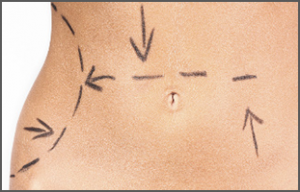4 Steps for Cosmetic Surgery: Minimize Scars
August 27th, 2012
Cosmetic plastic surgeons are trained to minimize scars following surgery. The surgical design plan determines where the scar(s) will be located. This determines the appearance after surgery. There are several choices to consider when designing incision placement based on the type of surgery I am doing. I evaluate placement using key solutions such as, whether it can be covered with clothing, camouflaged by make up, obscured by hair style, hidden within body orifices (nostrils) or concealed within the natural creases of the face or body. My overall philosophy is to utilize all these elements, so that minimal efforts are sufficient to keep any scars out of plain sight or minimized following cosmetic surgery. I suggest patients look at Before/After photos to help get an idea of the surgeon’s aesthetic skill in reviewing their final results.
I also custom design most surgery scars to be as short as possible. The length of a scar will ultimately be determined by the goals of the surgery and the limitations of technology. Obviously, a longer scar will usually be more conspicuous than a shorter scar. For instance, I use a 2 cm incision to do breast enlargement with saline implants. The implant simply cannot be inserted through a smaller scar at this time. However, as technology changes and there are advances in cosmetic surgery, our techniques evolve. It is important to refrain from exposing new scars to the sun. Tanning a scar before it has healed completely (soft and white) can cause discoloration, which may be permanent. Scars are not fully mature for up to six months, so keep them covered or applied with adequate sunscreen applications.
4 Steps for Cosmetic Surgery: Let’s Begin
August 23rd, 2012
13.8 million people had surgery cosmetic plastic surgery procedures in the United States in 2011, according to he American Society of Plastic Surgeons (ASPS). For all of the procedures involving actual surgery, these four universal steps are followed. In this series, I will describe each of the steps in doing cosmetic surgery. Let’s start at the beginning.
Step 1: Skin Incision.
The first step in all cosmetic surgery is to cut the skin. Whenever the skin is incised through its full thickness, a permanent scar is left. By permanent, I mean the scar will never completely go away, but as cosmetic surgeons, we are trained in ways to minimize the appearance of scars. So, before the surgery starts, a surgical plan is designed and typically drawn on the skin, similar to the diagram of a football play you might have seen on TV. Careful placement and design of the incision are crucial steps to minimize leaving a visible scar, which will continue to fade substantially with time.
This initial surgical plan represents the aesthetic design aspect that is the cornerstone of all cosmetic plastic surgery. Of course, with purely elective cosmetic surgery, I have the luxury of time to plan and execute an aesthetic design. This is not always the case in a hospital setting when critical surgery is necessary.
Please check back next time for Part 2 of this series.

